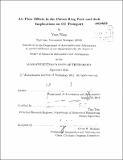| dc.contributor.advisor | Tian Tian. | en_US |
| dc.contributor.author | Wang, Yuan, S.M. Massachusetts Institute of Technology | en_US |
| dc.contributor.other | Massachusetts Institute of Technology. Dept. of Aeronautics and Astronautics. | en_US |
| dc.date.accessioned | 2013-02-13T21:34:38Z | |
| dc.date.available | 2013-02-13T21:34:38Z | |
| dc.date.copyright | 2012 | en_US |
| dc.date.issued | 2012 | en_US |
| dc.identifier.uri | http://hdl.handle.net/1721.1/76826 | |
| dc.description | Thesis (S.M.)--Massachusetts Institute of Technology, Dept. of Aeronautics and Astronautics, 2012. | en_US |
| dc.description | This thesis was scanned as part of an electronic thesis pilot project. | en_US |
| dc.description | Cataloged from PDF version of thesis. This thesis was scanned as part of an electronic thesis pilot project. | en_US |
| dc.description | Includes bibliographical references (p. 85). | en_US |
| dc.description.abstract | 3 different flow regimes of piston blowby air and their influences on oil transport are studied. It is found that air mainly interacts with oil close to the ring gaps and directly below the ring-liner contacts. Geometric features at the gaps to smoothen airflow and prevent flow detachments can increase blowby mass flow rate and thus drainage oil mass flow rate by up to 60%. Only oil within 1 to 2 gap widths distance from the gaps are transported through the gap by air drag and the engine pressure drop. Downstream of the ring gap, transported oil will either be caught in vortices directly below the ring gaps or pumped into the downstream ring groove due to the creation of a blowby stagnation point. Far away from the gaps, oil is mainly transported in axial direction through the grooves and the piston-liner interface. Low capillary numbers in the order of 10-5 indicate close to no oil transport into circumferential direction from blowby shear. The oil transport radially into the grooves is mainly determined by hydrostatics and capillary effects in the groove flanks whereas air in the second land only has an influence on oil transport by preventing bridging after TDC by creating a stagnation point directly below the rings on the liner. | en_US |
| dc.description.statementofresponsibility | by Yuan Wang. | en_US |
| dc.format.extent | 85 p. | en_US |
| dc.language.iso | eng | en_US |
| dc.publisher | Massachusetts Institute of Technology | en_US |
| dc.rights | M.I.T. theses are protected by
copyright. They may be viewed from this source for any purpose, but
reproduction or distribution in any format is prohibited without written
permission. See provided URL for inquiries about permission. | en_US |
| dc.rights.uri | http://dspace.mit.edu/handle/1721.1/7582 | en_US |
| dc.subject | Aeronautics and Astronautics. | en_US |
| dc.title | Air flow effects in the piston ring pack and their implications on oil transport | en_US |
| dc.type | Thesis | en_US |
| dc.description.degree | S.M. | en_US |
| dc.contributor.department | Massachusetts Institute of Technology. Department of Aeronautics and Astronautics | |
| dc.identifier.oclc | 825074427 | en_US |
